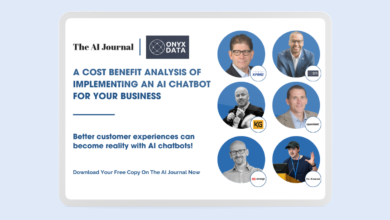
Launched in November 2022, ChatGPT has taken the world by storm, and you’d now find it difficult to go about your day-to-day without hearing about how ChatGPT is going to be used next. ChatGPT is an artificial intelligence (AI) chatbot, developed by Microsoft-backed OpenAI and built on top of the company’s GPT-3 family of large language models (LLMs). Use cases where ChatGPT is at play today include helping you to write a job description, supporting you with mundane tasks, or processing code. Users seem most intrigued by how it can make their lives easier. As such, businesses are taking note.
The technology behind the chat
LLMs are AI tools that can read, summarise, and translate texts that predict future words in a sentence. Having been trained on historical data, ChatGPT uses the data it is given to respond in a human-like way. OpenAI-trained ChatGPT using Reinforcement Learning from Human Feedback (RLHF), using supervised fine-tuning. Human AI trainers provided conversations to play both sides (the user and AI assistant), composed responses, and transformed dialogue datasets into a genuine dialogue format.
The Economist’s Ludwig Siegele spoke in December about why foundation models, or generative AI, could end up having an economic impact similar to that of electricity. A view that becomes more interesting as ChatGPT becomes embedded into our lives and organisations look at ways they can leverage it to support their customer and employee experiences and increase revenue.
Is ChatGPT the answer for a successful business?
It’s worth considering that if an end user was to ask ChatGPT a question, if ChatGPT gets it wrong, it’s fairly insignificant. But, if a user was to ask a question to a business and the business gets it wrong, the consequences are much higher, especially in high-emotion or important use cases.
ChatGPT is new and continuously learning and collecting data. It will be a long time before it has the data stored within its system to be able to answer every question and for it to be considered a genuinely helpful virtual assistant. And that’s where leading Conversational AI (CAI) technology comes in, which is available right now.
CAI platforms build and implement virtual assistants that allow users to interact with them through natural language conversations to provide a solution. These platforms include a range of tools and features that are necessary for any virtual assistant to function effectively from building, designing, and deploying a bot to including bot life cycle management, natural language processing (NLP) algorithms, machine learning models and enterprise integrations.
In contrast, ChatGPT is a specific machine learning model that is designed to generate human-like text based on a given prompt or context.
While ChatGPT in its current form acts as a chatbot, CAI goes that step further. This is where businesses should be looking to get ahead of their competitors, by not only using ChatGPT to help their general business needs, such as simply answering customer questions, but utilising it in a generative AI platform. This means taking the technology further, to aid both customers and employees in a way that is faster and more efficient than what is currently possible. This could include allowing a CAI platform to train employees, answer HR-related questions or making personalised suggestions for each customer based on their previous activity. CAI allows businesses to be proactive to a user’s needs.
The difference ChatGPT will make to enterprise
There are several reasons as to why ChatGPT is fundamentally different to a CAI platform. However, when utilised appropriately, ChatGPT can undoubtedly create a significant impact on people’s lives when integrated into virtual assistant technology.
Businesses should be asking themselves how new technologies such as ChatGPT can help develop and enhance their operations further. Some of the benefits are listed below:
- Automating admin tasks: ChatGPT has the potential to automate mundane tasks for businesses such as writing job descriptions and responding to applications. In turn, this gives employees more time to focus on other tasks that require more critical thinking.
- Increasing efficiency: In healthcare, ChatGPT could be used to provide personalised recommendations and treatment plans, or helping with scheduling appointments and managing patient records. By supporting healthcare professionals where admin takes up so much of their job, ChatGPT and CAI serve to make the healthcare system much more efficient and effective.
- Empowering employees and focussing on the customer: In retail, ChatGPT has forced businesses to look at their traditional chatbot, with the majority of being simple and inadequate – often not knowing or understanding customers in context. Additionally, CAI platforms can optimise in-store interactions, increasing contact centre efficiency, speed up admin-intensive tasks such as IT requests, and re-elevate marketing methods with real-time product promotion.
- Understanding the business: Having been trained on vast amounts of knowledge, ChatGPT has an enhanced understanding of context. When embedded into a CAI platform at the back-end of a business, ChatGPT will know everything about that organisation, based on its historic data. As such, it should be seen as a trusted virtual assistant. For example, new employees could ask a virtual assistant questions on their role that would usually go through HR or a line manager. This saves time for both parties, while the organisation can be sure that the information is correct.
The future? Complimenting your CAI platform with ChatGPT
For every enterprise, the future is technology that leverages next generation LLMs to elevate their total experience across every digital channel.
ChatGPT falls short when it comes to providing the features and capabilities necessary for enterprise-grade users. CAI platforms permit businesses and organisations to maintain an end-to-end lifecycle including designing, training, testing and deploying integrative virtual assistants that can truly interact with customers and users in a human-like way. These platforms typically provide tools and frameworks for designing, building, and deploying chatbots, as well as APIs and other integration options for connecting the chatbots to various communication channels, such as websites, messaging apps, and voice assistants. As such, ChatGPT should be used and integrated within a CAI platform in order to reap the benefits of human-like interactions that are beneficial for the customer experience. And as ChatGPT progresses, so too will the data it stores and learns from.
ChatGPT is just one piece of the puzzle when it comes to building and deploying a successful CAI platform.





